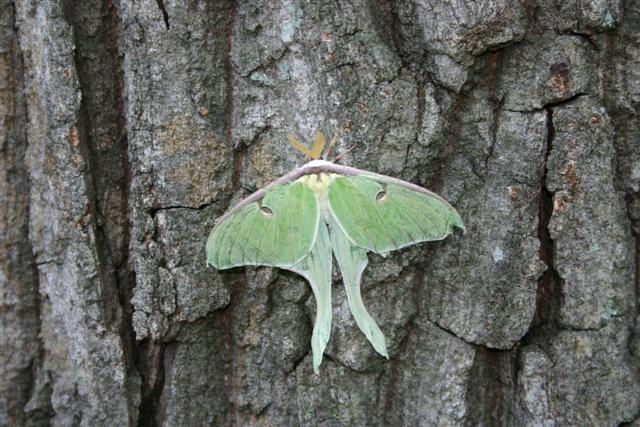Georgia Gardener Newsletter Design Tip: March 6, 2008
Attractive luna moth
Pest versus Pal
Although technically the term "bug" is not scientific, I like to use it as a catchall name to refer to creatures that are
true insects and those that are not (spiders and spidermites, etc.).
Not a week goes by that I don't read an email or handle a call from someone wanting to know how to rid themselves of
bugs in the garden. My first question is always what type of bug is it. Most people don't know what it is but they know
they want it gone. That's really an unfortunate attitude to take because without bugs we would soon go hungry in a colorless
world filled with increasing piles of dead creatures.
Most bugs are not pests. In fact, about 97% of the bugs you encounter in a garden are either beneficial or harmless. Let me
repeat, 97% are not causing any harm. That leaves about 3% of the remaining bugs to be labeled as pests. In addition to
doing some damage in the garden these pests are also running for their lives, usually from the other 97%.
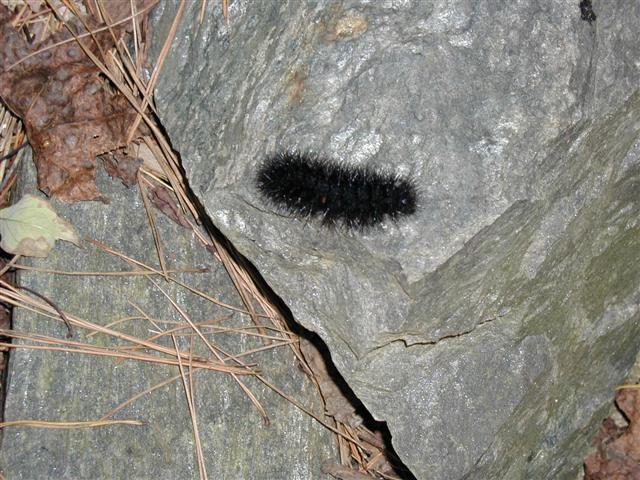
|
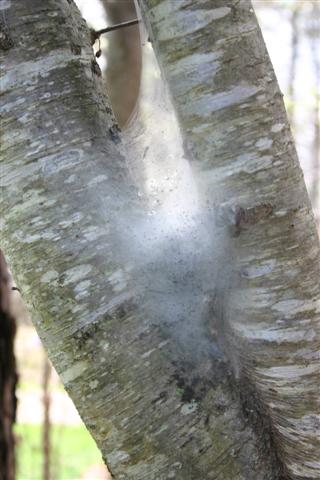
|
| Woolly Caterpillar | Tent Caterpillars |
Some insects, although technically classified as pests do so little damage or for a short amount of time that they don't warrant
intervention. Such is the case of the woolly and tent caterpillars, which are the larval stages of two different moths.
Woolly caterpillars eat the leaves of various plants but their numbers are usually not high enough to cause problems. Tent
caterpillars are very conspicuous in the spring with their large webs and huge populations. Although they eat the leaves of
the trees they infest (cherries, sourwoods, etc.) they are quickly gone with little long term harm to the tree. However, because
of their unsightly appearance, people strive to wipe them out. Usually just opening up the web with a long stick will leave them
vulnerable to predators. Problem solved.
Pick Your Battles
No matter what our elected officials tell us, there are two wars we will never win: the war on weeds and the war on bugs. You
may get temporary relief by using pesticides, but in the long run the bugs will bounce back. You will simply have to pick your
battles but the war will never end.
The first and most important step is to know your enemy. Identify the bug that you are
concerned about. If you have trouble, take it or a good picture to a nursery or your local Cooperative Extension Service
(1-800-ASKUGA1). Once the bug has been identified you will know whether it's in the beneficial or pest category. If it is a true pest,
try to use the least toxic form of control as your first choice. Remember, that many of the pesticides on the market will
not only get the pest but also kill your beneficial bugs. If overused, pesticides can so diminish the population of beneficial bugs that
the pests will rebound with no predators to keep them in check. You can actually end up with a more severe problem. Sometimes it's
best to do nothing and let the beneficial bugs tackle the problem.
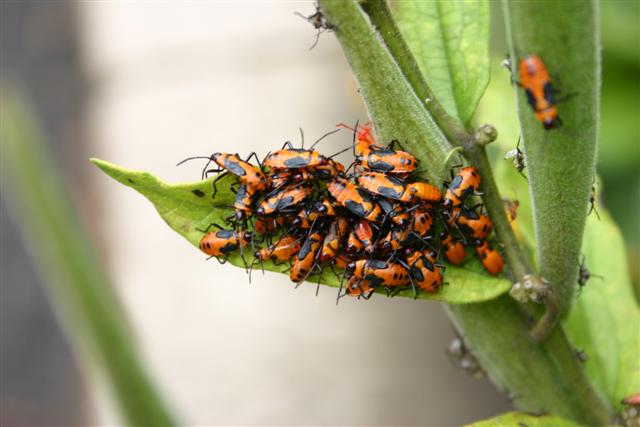
|
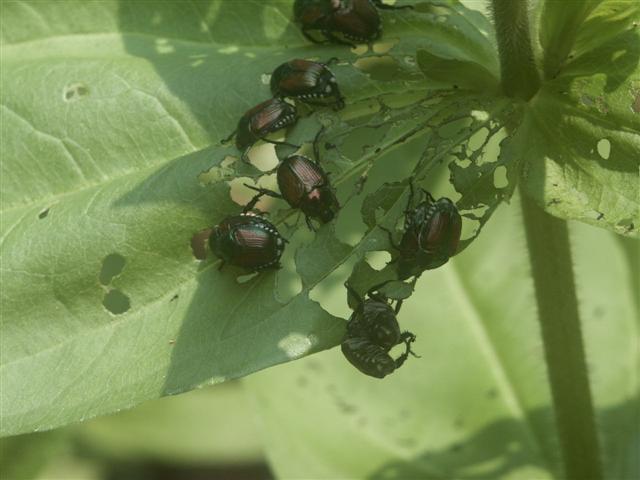
|
| Milkweed Bugs | Japanese Beetles (image courtesy of Walter Reeves) |
The milkweed bug is an annoying pest to me. Large numbers suck the life out of my milkweed plants which I grow for the butterflies.
They also have few predators because they concentrate the same toxins from the milkweed into their tissues as the monarch butterfly
does for protection. Because of the presence of butterflies, I usually hand pick or hose off (and step on) these annoying bugs.
Japanese beetles are really voracious garden pests that come out in huge numbers in June. They can devastate roses, crape myrtles,
flowering cherries and a number of other plants. It seems to do no good to spray them. You can kill hundreds and more will be back the
next day. You may wish to use systemic insecticides taken up by the plant which will kill the beetles without harming beneficial bugs.
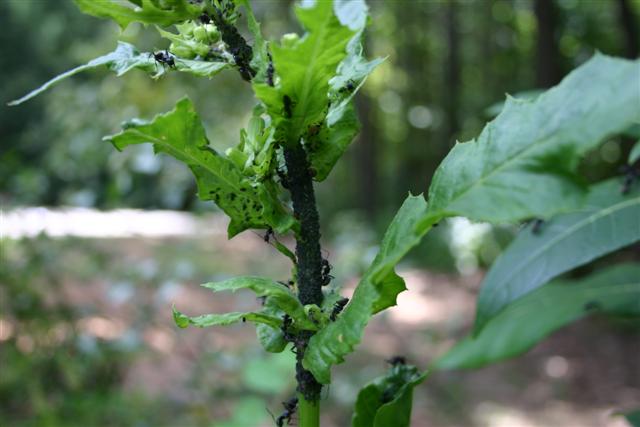
|

|
| Ants "Milking" Aphids | Tobacco Hornworm |
There is some curious behavior amongst ants which are normally considered beneficial bugs (except for fire ants). Occasionally,
you will see ants attracted to aphids. The ants actually protect and milk the aphids for their honeydew in a similar way in
which we protect and milk cows. At this point, the ants have become guilty by their association with the pest aphids. It may
be necessary to treat the plant to remove both the aphids and the ants. When not protecting aphids, ants have an
important role in the garden and should be tolerated as best as possible. Aphids are well known pests on a variety of garden
plants. They are easily killed by hosing them off the plant where they fall prey to other bugs. Once again, I would
recommend the use of systemic pesticides for ornamentals (not edible plants) that are plagued by aphids. The tobacco
hornwom and its cousin the tomato hornworm are the larval stages of two separate moth species. These bugs feed on solanaceous
plants (tomatoes, tobacco primarily but potatoes, peppers and eggplants to a lesser extent). These caterpillars can completely
destroy a tomato plant in what seems like the blink of an eye. Once they reach a certain size, they can be easily seen
and removed by hand.
There are some bad bugs that seem to attack the same plants over and over, year after year. These should be dealt with before
their numbers grow too large to be easily controlled. In this category I would put whiteflies on gardenias, scale on
euonymus, aphids on crape myrtles and roses. Systemic pesticides (those absorbed by the plant) that contain Imidacloprid seem
to work well on these pests.
The Good Guys
As I said at the beginning, approximately 97% of all bugs are beneficial or harmless. With that many good guys in the garden,
why not have them do the work for you? When you get down on the bug level, it's a very violent world with predators chasing
prey all over the place. It's been that way for millions and millions of years and plants have managed to survive through it all.
Unless you see a pest population exploding out of control, it may be better to do nothing. Yes, you may have to endure a bit
of damage to your plants, but you won't be putting harming chemicals into your landscape.
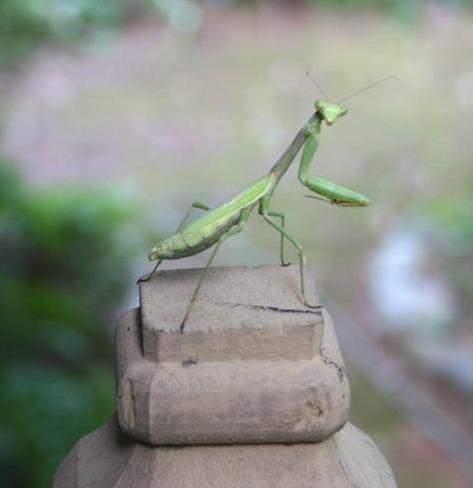
|
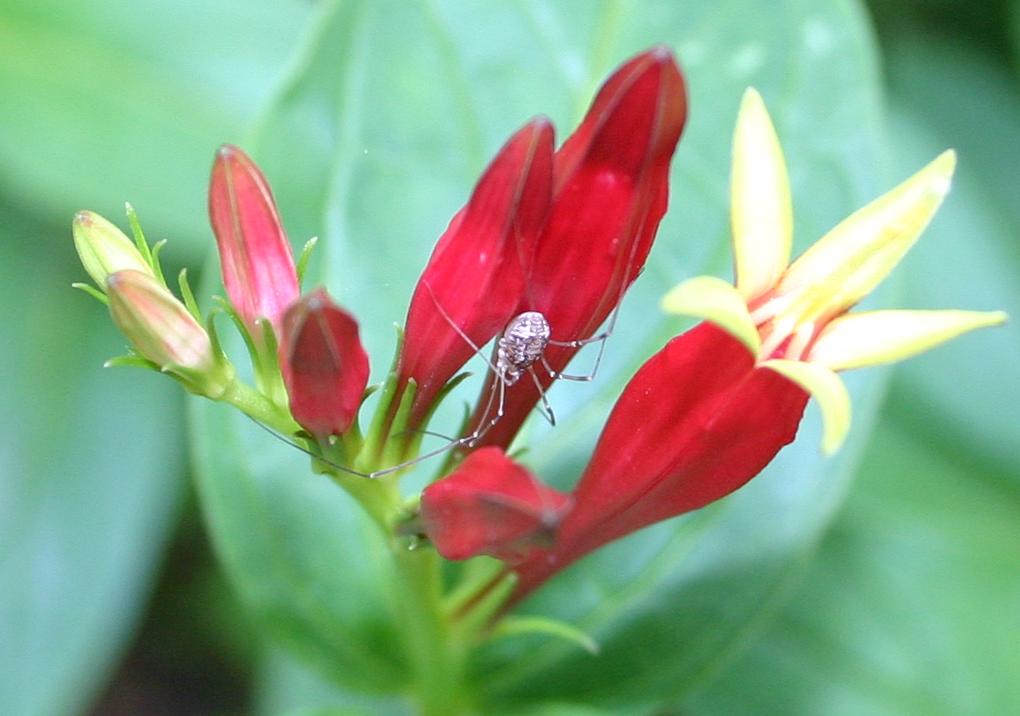
|
| Praying Mantis (image courtesy of Emily Schrum) | Spider |
Most predatory bugs are beneficial. These include most ants, praying mantises, spiders, ladybugs, lacewings, wasps, hornets
and so forth. They patrol the garden and prey on many pest species. They should be welcomed and encouraged.
Pest Alert
Because the drought has stressed many of our trees, we're unforunately probably looking at an explosion of some
very destructive pests this year. These include:
Southern Pine Beetle
Asian Ambrosia Beetle
Hemlock Woolly Adelgid (pictured below)
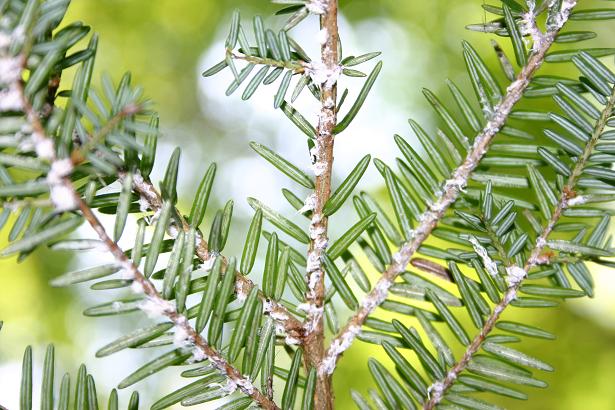
These three pests are threatening to wipe out millions of trees. In the case of the adelgid, our native hemlocks may end up
going the way of the American chestnut and American elm.
Resources
There are plenty of resources available on the internet to identify bugs. There is also one book that I highly recommend:
Garden Insects of North America.
Copyright © 2008 by Theresa Schrum - All rights reserved
No part of this website may be reproduced without the expressed written permission of Theresa Schrum
